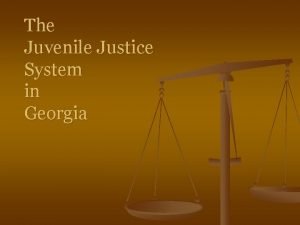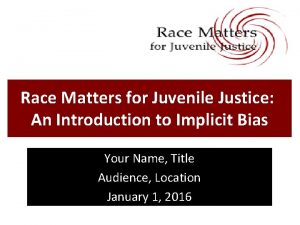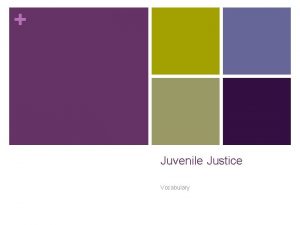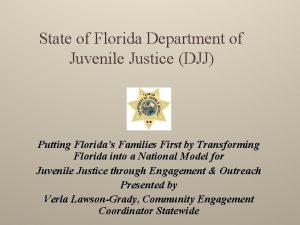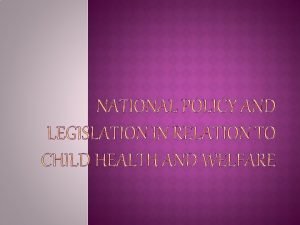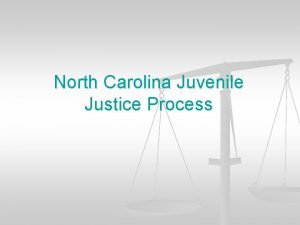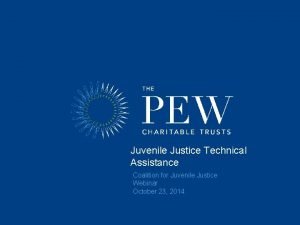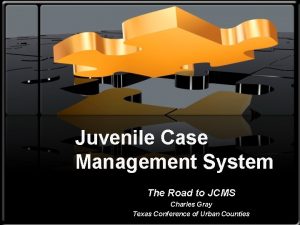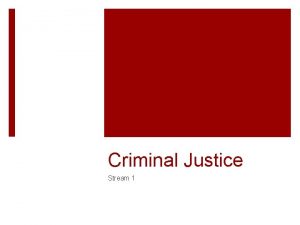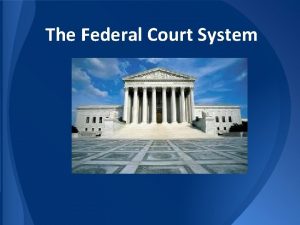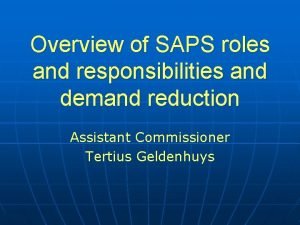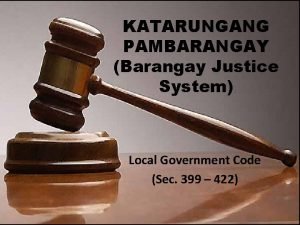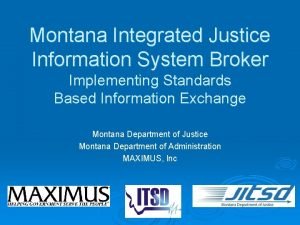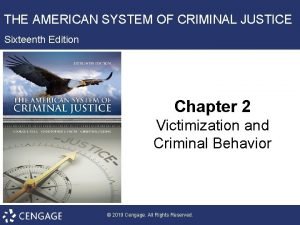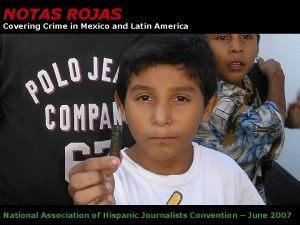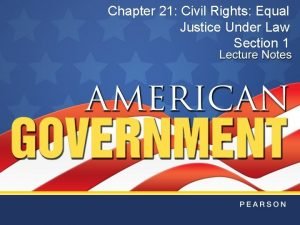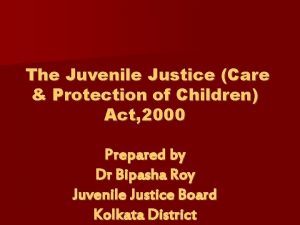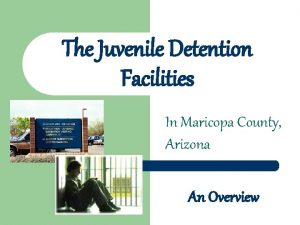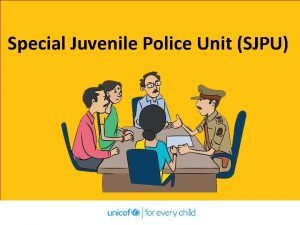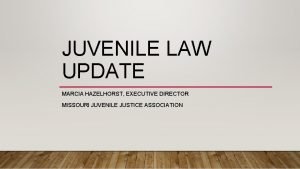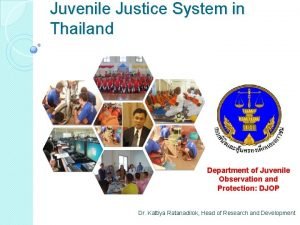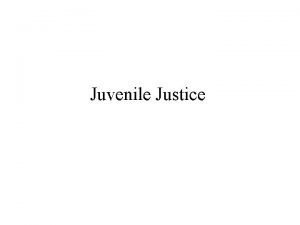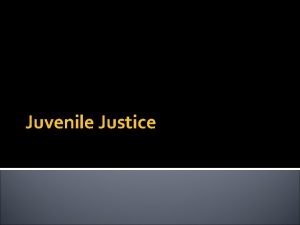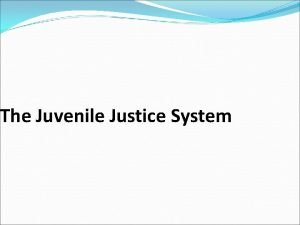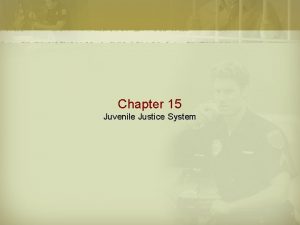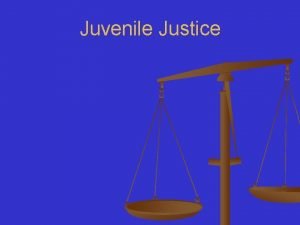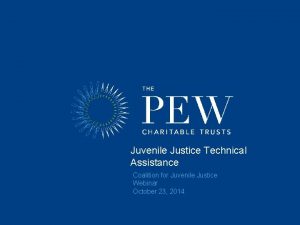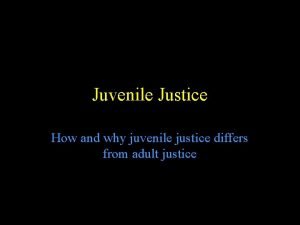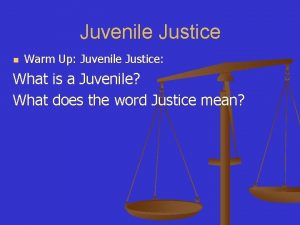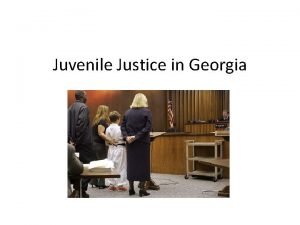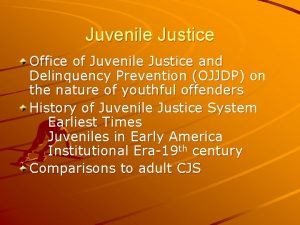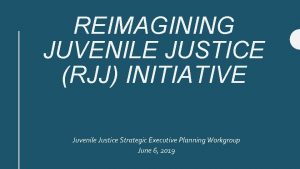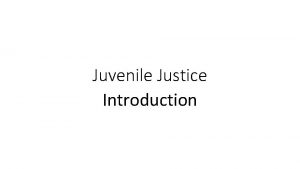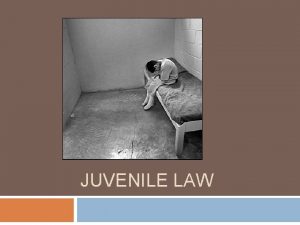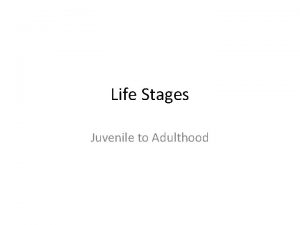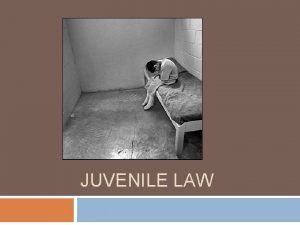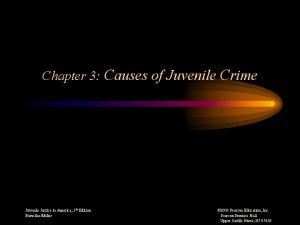13 CHAPTER The Juvenile Justice System The Evolution






























- Slides: 30

13 CHAPTER The Juvenile Justice System

The Evolution of American Juvenile Justice § The Child-Saving Movement § § § At the beginning of the 1800 s, juvenile offenders were treated the same as adult offenders Child saving organizations convinced local legislatures to pass laws that allowed them to take control of children who exhibited criminal tendencies or had been neglected by parents Based on Parens Patriae § § The state has a responsibility to look after the wellbeing of child and to assume the role of parent if necessary Institutions were open to separate children from their environment § New York’s House of Refuge opened in 1825

The Evolution of American Juvenile Justice § The Illinois Juvenile Court § § § Established in 1899 The first court specifically for juveniles based on the premise that children are not fully responsible for criminal conduct and are capable of being rehabilitated Differences from adult court: § § § No juries Different terminology No adversarial relationship Confidentiality By 1945 every state had a juvenile court modeled after Illinois

The Evolution of American Juvenile Justice § Status Offending: § Status offenders are juveniles who have engaged in behavior deemed unacceptable for those under a certain statutorily determined age § § Only illegal because of the age of the offender Juvenile Delinquency: § Behavior that is illegal under federal or state law that has been committed by a person who is under an age limit specific by statute

The Evolution of American Juvenile Justice

The Evolution of American Juvenile Justice § Constitutional Protections and the Juvenile Court § § There was a lack of procedural protections in the juvenile court In the 1960 s and 1970 s the Supreme Court issued several rulings that significantly changed the juvenile justice system § Kent vs. United States (1966) § § In re Gault (1967) § § § Juveniles have a right to counsel and a hearing if the judge is considering sending the case to adult court Considered to be the most important case concerning juvenile justice Juveniles are entitled to many of the same basic procedural safeguards granted to adult offenders Other Important Court Decisions § § In re Winship (1970) Breed vs. Jones (1975)

Discussion Question #1 § About 140, 000 status offenses are processed by juvenile courts in the United States each year. § The most common status offenses are: § § § Truancy (skipping school) Liquor law violations Running away from home Curfew violations Should the government continue to regulate this behavior or should the families of the children be the ones to “handle” these situations? § § What are the pros and cons associated with the government handling these violations? What are the pros and cons associated with allowing the families to handle these violations?

Determining Delinquency Today § Major court cases moved the juvenile justice system away from parens patriae and towards a more formalized system similar to the adult system § The Age Question § The majority of states allow for the prosecution of § § juveniles fifteen years of age and younger as adults Juveniles cannot remain incarcerated in juvenile detention centers past their 18 th or 21 st birthdays The Culpability Question § When do juveniles theoretically understand the § difference between right and wrong? Should juveniles be held to the same standards of competency as an adult? § § Juvenile Behavior Diminished Guilt § Roper v. Simmons (2005) § Graham v. Florida (2010) § Miller v. Alabama (2012)

Trends in Juvenile Delinquency

Trends in Juvenile Delinquency § Delinquency by the Numbers § § The Rise and Fall of Juvenile Crimes § § In 2012 juveniles accounted for 11. 7% of violent arrests and 10. 8% of criminal activity arrests in general Juvenile arrest rates for violent crimes have fluctuated dramatically over the past three decades In the 2000 s, juvenile crime rates decreased at a rate similar to adults Various theories to explain the decrease in juvenile offending Girls in the Juvenile Justice System § Arrest rates for girls are declining more slowly than those for boys § A Growing Presence § Family-Based Delinquency

Trends in Juvenile Delinquency § School Violence and Bullying § Safe Schools § Juvenile victimization and delinquency rates increase during the school day § § The most common juvenile crimes are most likely to take place on school grounds Violent crime is not commonplace in American schools Because of a few high profile cases schools are using security cameras, controlling access and becoming less forgiving places Bullied Students § § Bullying is defined as overt acts taken by students with the goal of intimidating, harassing, or humiliating other students Can include physical abuse, verbal abuse, social and emotional abuse, cyber abuse

Discussion Question #2 § As a result of some of the recent high profile school shootings some administrators are calling for increasing security measures at all schools. § What are your thoughts about the following recommendations? § § § Placing an armed law enforcement officer in every school Permitting school teachers to be armed with a firearm while inside the school Do you have other recommendations that you believe would be more appropriate?

Factors in Juvenile Delinquency § The age-crime relationship § § § The older a person is the less likely he or she will exhibit criminal behavior Aging out explains the fact that criminal behavior declines with age Age of onset is the age at which a juvenile first exhibits delinquent behavior § Consistent predictor of future criminal behavior § Juvenile justice resources should be concentrated on the youngest offenders, with the goal of preventing crime and reducing the long-term risks for society

Factors in Juvenile Delinquency § Substance Abuse § Plays a strong role in criminal behavior for adults and juveniles § Strong Correlation § § Drug use is associated with a wide range of antisocial and illegal behaviors by juveniles Strong Causation? § Most youths who become involved in antisocial behavior do so before their first experience with alcohol or drugs § Substance abuse is a form of delinquent behavior rather than a cause

Discussion Question #3 § Recently there have been two states to pass laws to decriminalize the sale and possession of marijuana. § There is still a very heated debate occurring in many other states to continue to criminalize the sale and possession of marijuana. § Imagine you are a state lawmaker and this debate is occurring in the legislature. § § Discuss the relationship between marijuana use and other criminal acts. Do you believe that decriminalizing marijuana would increase juvenile crime rates in your state?

Factors in Juvenile Delinquency § Child Abuse and Neglect § § Child Abuse is defined as the infliction of physical or emotional damage on a child Child neglect refers to deprivations children undergo by their parents § § § Love Shelter Food Proper care One in ten children in the United States experience mistreatment at the hands of a close family member Children who experience neglect or violence in their home suffer from physical, emotional, and mental health problems at a much greater rate than their peers

Factors in Juvenile Delinquency

Factors in Juvenile Delinquency § Gangs § § Youths will turn to the peers when they cannot find the stability and support they require in their family structure A gang is viewed as a group of three or more people who: 1. Self-identify as an entity separate from the community by special clothing, vocabulary, hand signals, and names 2. Engage in criminal activity § § Estimated to be 30, 000 gangs with approximately 785, 000 members in the United States Juveniles who experience previously discussed risk factors are more likely to join a gang

Factors in Juvenile Delinquency § Gangs § Who Joins Gangs? § § Average gang member is 17 -18 years old Gangs tend to have racial or ethnic characteristics § § § § 46% of gang members are Hispanic 35% of gang members are African American 11% of gang members are White Researchers do not believe that race or ethnicity is the dominant factor in gang membership Gang members seem to come from lower-class or working-class communities Starting to see an increasing number from the suburbs and rural counties A very small percentage of youth gang members are female

Factors in Juvenile Delinquency § Gangs § Why Do Youths Join Gangs? § § § Identity Protection Fellowship Criminal activity Intimidation

First Contact: The Police and Pretrial Procedures § Police Discretion and Juvenile Crime § § § Police arrest about 1. 1 million youth under 18 each year Police power with regard to juveniles is greater than with adults Police can also act in loco parentis § § In the place of the parent, to protect the juvenile Police have a great deal of discretion in deciding what to do with juveniles who have committed crimes or status offenses § Low-visibility decision making § A term used to describe the discretionary power police have in determining what to do with misbehaving juveniles

First Contact: The Police and Pretrial Procedures § The police are usually the ones to refer a juvenile to the court system § § Anyone with a valid reason, including parents, relatives, welfare agencies, and school officials, can initiate a referral to the juvenile court Police generally consider the following factors in making their discretionary decisions: § § § The nature of the child’s offense The offender’s past history of involvement with the juvenile justice system The setting in which the offense took place The ability and willingness of the child’s parents to take disciplinary action The attitude of the offender

First Contact: The Police and Pretrial Procedures § Intake § The process by which an official of the court must decide whether to file a petition, release the juvenile, or place the juvenile under some other form of supervision § § A petition is a formal document filed with the court alleging that the juvenile is a delinquent or a status offender Requests that the court either hear the case or transfer the case to adult court

First Contact: The Police and Pretrial Procedures § Pretrial Diversion § § Diversion refers to the process of removing low-risk offenders from the formal juvenile justice system by placing them in community-based rehabilitation programs Three categories of diversion § § Probation Treatment and aid Restitution Proponents of diversion believe that labeling juveniles as delinquent leads to further delinquent behavior

First Contact: The Police and Pretrial Procedures § Transfer to Adult Court § § § The American juvenile justice system has shifted away from ideals of treatment and toward punishment Transfer to adult court has been one of the most popular means of “getting tough” on delinquents Each year, six thousand delinquent youth are waived to adult criminal court § Judicial transfer § § § Juveniles are most commonly transferred to adult courts through a judicial waiver The judge makes the decision based on the offender’s age, the nature of the offense, and any criminal history Other methods of transfer § § Automatic transfer (legislative waiver) Prosecutorial waiver

First Contact: The Police and Pretrial Procedures § Detention § § § Intake officers may place the offender in detention in a secure facility until the disposition process begins Most jurisdictions require a detention hearing be held within twenty-four hours Issues to consider to justify detention § § § Whether the child poses a danger to the community Whether the child will return for the adjudication process Whether defendants will provide protection for the child

Trying and Punishing Juveniles § Adjudication § § § The process by which the court determines whether the offender is delinquent or in need or some form of court supervision Most state juvenile codes dictate a specific set of procedures that must be followed in the adjudicatory hearing At the end of the adjudicatory hearing, the judge is generally required to rule on the legal issues and evidence that have been presented § The judge will determine whether the respondent is delinquent or in need of court supervision

Trying and Punishing Juveniles § Disposition § § § Once a juvenile has been adjudicated delinquent, the judge must decide what steps will be taken toward treatment and/or punishment Most states provide for a separate disposition hearing following the adjudicatory hearing Sentencing Juveniles § Judges will usually order a predisposition report § § Provides the judge with relevant background material to aid in the disposition decision Judicial Discretion § Judges have a great deal of discretion in choosing one of § several disposition possibilities The judge can choose between incarceration, probation, or community treatment § The judge will consider the seriousness of the offense, history of delinquency, family situation, and the offender’s attitude

Trying and Punishing Juveniles § Juvenile corrections is based on the concept of graduated sanctions and is based upon the punishment matching in seriousness the severity of the wrongdoing § Probation § § The most common form of juvenile corrections is probation The majority of juveniles will never receive a disposition more severe than probation The organization of juvenile probation is similar to adult probation Confining Juveniles § § About 70, 000 American youths are incarcerated in juvenile correctional facilities in the United States Non-secure confinement: § § Secure confinement § § Includes foster care programs, group homes, family group homes, and rural programs Boot camp and training schools Aftercare § Therapeutic, educational, and counseling programs made available to juvenile delinquents after they have been released from a correctional facility

Discussion Question #4: § Many youth training schools are plagued by many of the same problems as adult prisons and jails. § These include: § § Inmate-on-inmate violence Substance abuse Gang wars Overcrowding § Does the government have the responsibility of protecting juveniles from these problems common to youth training schools? § Can exposure to these conditions inside training schools be detrimental to the rehabilitation of juvenile offenders?
 Juvenile justice system georgia
Juvenile justice system georgia Ra 9344 juvenile justice and welfare act
Ra 9344 juvenile justice and welfare act Juvenile justice system in georgia
Juvenile justice system in georgia Minnesota juvenile justice system
Minnesota juvenile justice system Race matters for juvenile justice
Race matters for juvenile justice Unit 2 criminal law and juvenile justice
Unit 2 criminal law and juvenile justice Cottage reformatories
Cottage reformatories State of florida department of juvenile justice
State of florida department of juvenile justice Juvenile justice alternative education program
Juvenile justice alternative education program Juvenile justice act 2000
Juvenile justice act 2000 North carolina juvenile justice
North carolina juvenile justice Coalition for juvenile justice
Coalition for juvenile justice Juvenile case management system
Juvenile case management system Four pillars of criminal justice system
Four pillars of criminal justice system Us circuit court map
Us circuit court map Arizona criminal justice information system
Arizona criminal justice information system Responsibilities and functions of saps
Responsibilities and functions of saps Pangkat tagapagkasundo
Pangkat tagapagkasundo Criminal justice wedding cake diagram
Criminal justice wedding cake diagram Integrated justice system
Integrated justice system The american system of criminal justice 16th edition
The american system of criminal justice 16th edition Mexico criminal justice system
Mexico criminal justice system Chapter 21 civil rights equal justice under law
Chapter 21 civil rights equal justice under law Chapter 11 and then there were none
Chapter 11 and then there were none Juvenile act
Juvenile act Maricopa county juvenile detention
Maricopa county juvenile detention State of ct division of criminal justice
State of ct division of criminal justice Sjpu
Sjpu Polyarticular arthritis
Polyarticular arthritis Missouri juvenile officer performance standards
Missouri juvenile officer performance standards Department of juvenile observation and protection
Department of juvenile observation and protection
